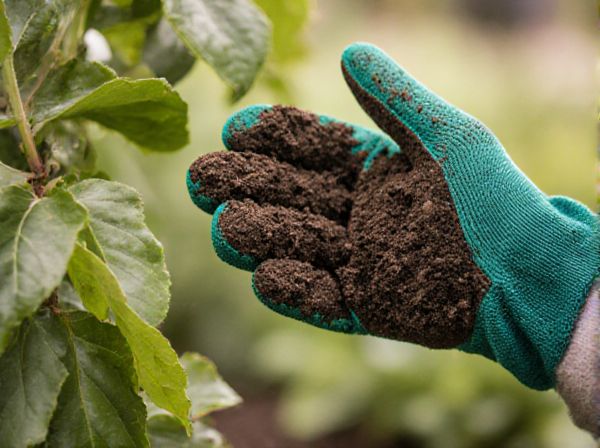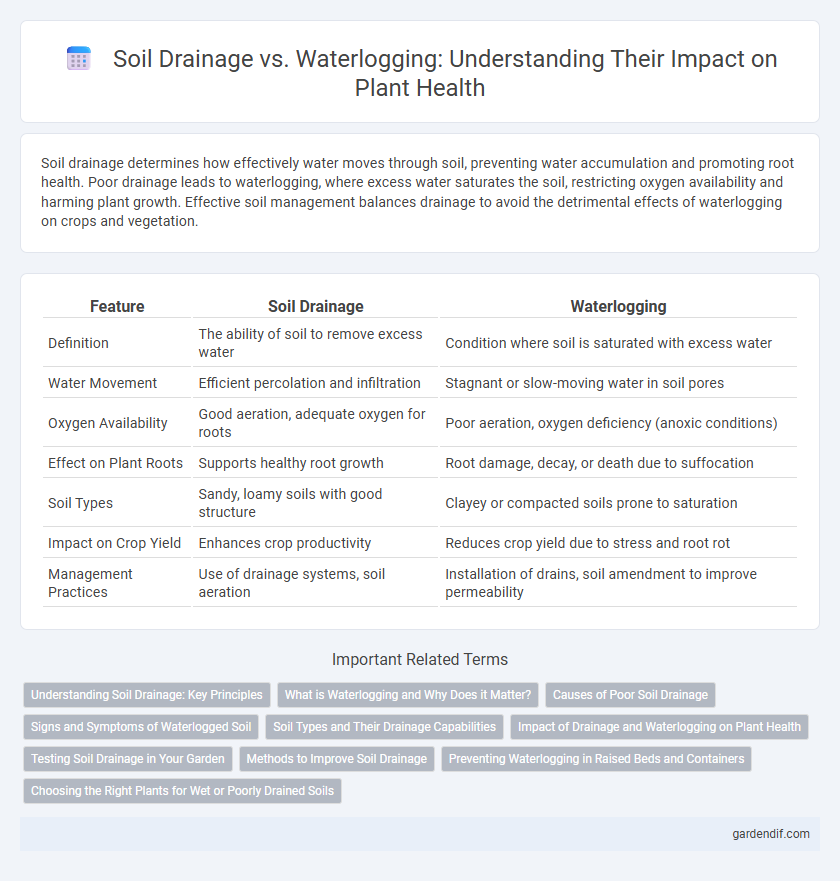
Soil Drainage vs Waterlogging Illustration
Soil drainage determines how effectively water moves through soil, preventing water accumulation and promoting root health. Poor drainage leads to waterlogging, where excess water saturates the soil, restricting oxygen availability and harming plant growth. Effective soil management balances drainage to avoid the detrimental effects of waterlogging on crops and vegetation.
Table of Comparison
| Feature | Soil Drainage | Waterlogging |
|---|---|---|
| Definition | The ability of soil to remove excess water | Condition where soil is saturated with excess water |
| Water Movement | Efficient percolation and infiltration | Stagnant or slow-moving water in soil pores |
| Oxygen Availability | Good aeration, adequate oxygen for roots | Poor aeration, oxygen deficiency (anoxic conditions) |
| Effect on Plant Roots | Supports healthy root growth | Root damage, decay, or death due to suffocation |
| Soil Types | Sandy, loamy soils with good structure | Clayey or compacted soils prone to saturation |
| Impact on Crop Yield | Enhances crop productivity | Reduces crop yield due to stress and root rot |
| Management Practices | Use of drainage systems, soil aeration | Installation of drains, soil amendment to improve permeability |
Understanding Soil Drainage: Key Principles
Soil drainage refers to the ability of soil to remove excess water through gravitational flow and capillary movement, which is critical for sustaining plant growth and preventing root diseases. Effective soil drainage depends on soil texture, structure, and porosity, influencing water infiltration rates and aeration. Poor drainage leads to waterlogging, causing oxygen deprivation in roots and nutrient leaching, ultimately reducing crop productivity.
What is Waterlogging and Why Does it Matter?
Waterlogging occurs when excess water saturates soil pores, reducing oxygen availability essential for root respiration and microbial activity. This condition leads to poor plant growth, root rot, and decreased agricultural productivity due to impaired nutrient uptake. Effective drainage systems prevent waterlogging by facilitating proper soil aeration and maintaining optimal moisture levels for healthy crop development.
Causes of Poor Soil Drainage
Poor soil drainage is primarily caused by high clay content, compacted soil layers, and inadequate organic matter, which restrict water movement and air circulation. Soil structure deterioration, often due to heavy machinery or over-tillage, reduces pore space essential for water infiltration. In contrast, waterlogging occurs when excess water accumulates due to poor drainage, leading to oxygen-deficient conditions harmful to plant roots.
Signs and Symptoms of Waterlogged Soil
Waterlogged soil exhibits distinct signs such as persistent surface water, spongy or muddy texture, and a sour or musty odor due to anaerobic conditions. Plants growing in waterlogged soil often show symptoms like yellowing leaves, stunted growth, wilting despite wet soil, and root rot caused by oxygen deprivation. These indicators highlight poor drainage and soil saturation, severely impacting plant health and soil structure.
Soil Types and Their Drainage Capabilities
Sandy soils exhibit excellent drainage due to their large particle size and high permeability, allowing water to quickly pass through and preventing waterlogging. Clay soils, composed of fine particles, retain water and often suffer from poor drainage, leading to waterlogged conditions that inhibit root oxygenation. Loamy soils balance drainage and moisture retention effectively, supporting healthy plant growth by maintaining adequate aeration without excessive water accumulation.
Impact of Drainage and Waterlogging on Plant Health
Proper soil drainage prevents waterlogging, ensuring roots receive adequate oxygen for healthy growth and nutrient uptake. Waterlogged soils create anaerobic conditions that hinder root respiration, leading to reduced plant vigor, increased susceptibility to diseases, and impaired nutrient absorption. Effective drainage mitigates these risks, promoting robust root development and optimal plant health.
Testing Soil Drainage in Your Garden
Testing soil drainage in your garden involves digging a hole about one foot deep and filling it with water to observe how quickly the water drains. Soils with good drainage typically absorb water within 1 to 2 hours, preventing waterlogging that can suffocate roots and promote disease. Slow drainage indicates poor soil structure or compaction, requiring amendments such as organic matter or installation of drainage systems.
Methods to Improve Soil Drainage
Improving soil drainage involves techniques like installing subsurface drain tiles or French drains to effectively channel excess water away from root zones. Incorporating organic matter such as compost enhances soil structure, increasing porosity and water infiltration rates. Raised beds and contour farming also promote better runoff management, reducing waterlogging risks in agricultural fields.
Preventing Waterlogging in Raised Beds and Containers
Proper soil drainage is essential for preventing waterlogging in raised beds and containers, which can lead to root rot and plant stress. Incorporating well-draining materials like perlite, sand, or compost improves aeration and moisture balance, facilitating excess water runoff. Elevating planting areas and using containers with adequate drainage holes also ensure excess water does not accumulate, maintaining optimal soil health.
Choosing the Right Plants for Wet or Poorly Drained Soils
Selecting plants adapted to wet or poorly drained soils is crucial for preventing waterlogging and promoting healthy growth. Species such as willows, cattails, and sedges thrive in saturated conditions by efficiently tolerating low oxygen levels in the root zone. Choosing native wetland plants enhances soil structure and reduces the risk of root rot, improving overall soil drainage function.
Soil Drainage vs Waterlogging Infographic

 gardendif.com
gardendif.com